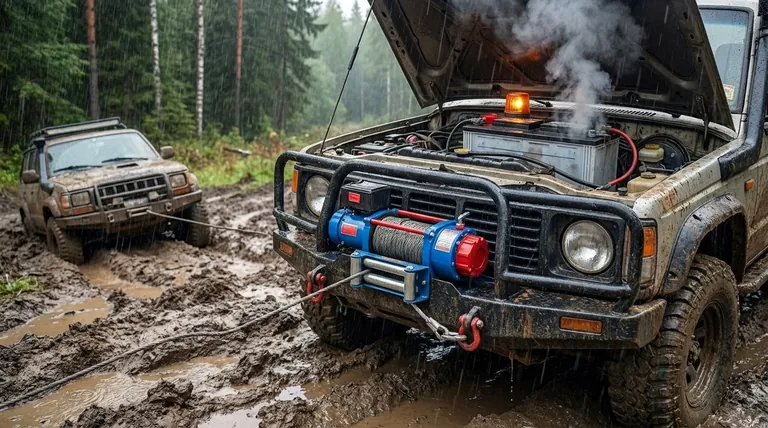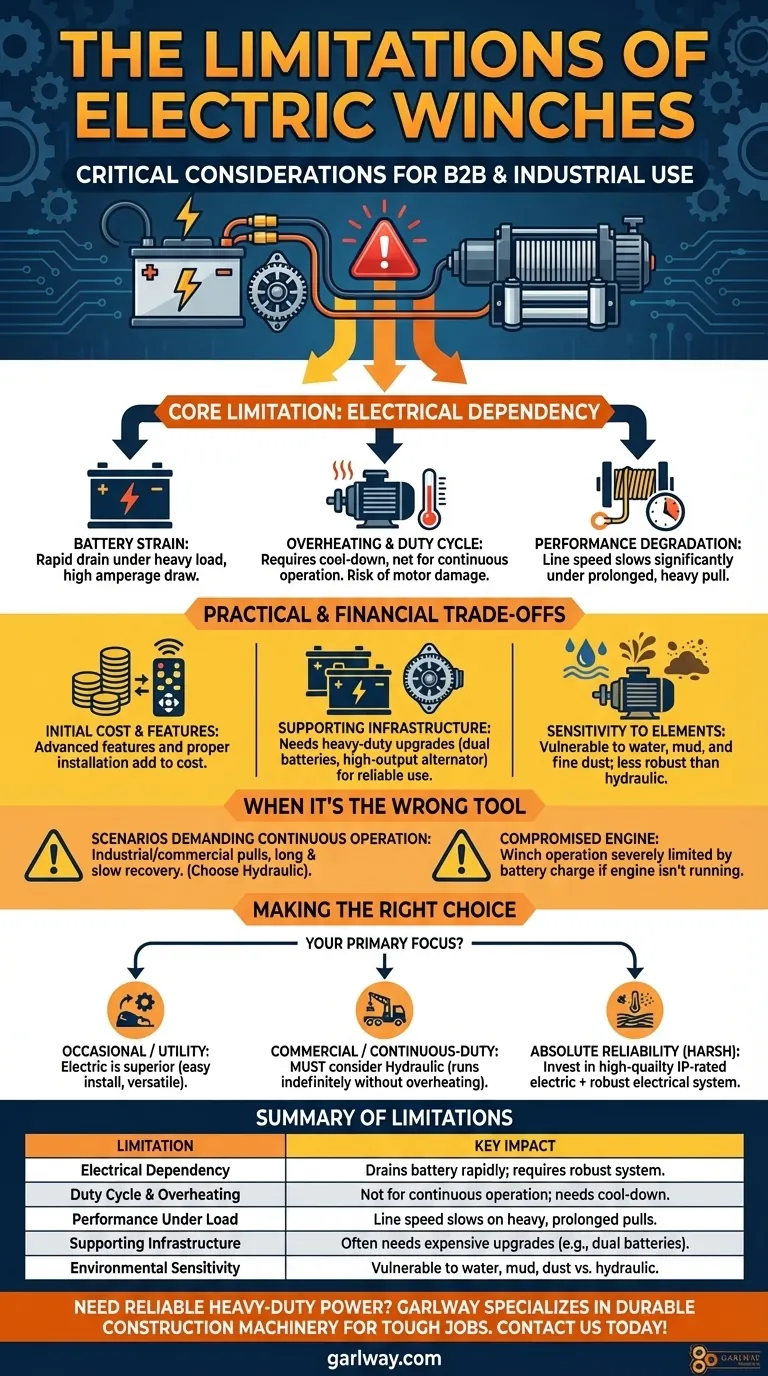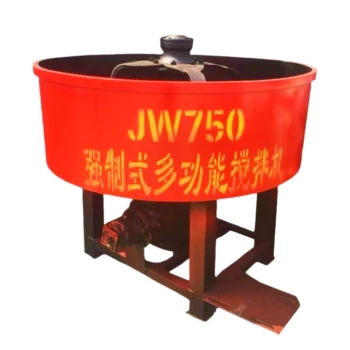While incredibly versatile and popular, electric winches are not without their critical limitations. Their primary drawback is a direct reliance on a finite electrical power source, which makes them less suitable for prolonged, continuous-duty operations. This dependency can lead to significant battery drain, performance degradation under heavy load, and potential overheating, especially when not supported by a robust vehicle electrical system.
The core limitation of an electric winch is its electrical dependency. This single factor creates a cascade of potential issues, from rapid battery drain and motor overheating during long pulls to the higher costs associated with the electrical infrastructure needed for reliable, heavy-duty work.

The Core Limitation: Electrical Dependency
An electric winch's greatest strength—its self-contained power system—is also the source of its most significant weaknesses. Every operational constraint stems from its reliance on your vehicle's electrical system.
The Strain on Your Vehicle's Battery
Under a heavy load, an electric winch can draw hundreds of amps, placing an enormous strain on your vehicle's battery and alternator.
Running the winch for an extended period without the engine on can drain a battery in minutes, potentially leaving you stranded. Even with the engine running, the stock alternator may not keep up with the demand.
Overheating and Duty Cycle
Electric motors generate significant heat under load. They are not designed for the continuous, non-stop operation that a hydraulic winch can provide.
This limitation is defined by the winch's duty cycle—a specification that dictates how long it can run before it requires a cool-down period. Exceeding this can lead to permanent motor damage.
Performance Degradation Under Load
As the electrical system is taxed and the motor heats up, the winch's line speed can slow down considerably. This is especially noticeable during long, heavy pulls where performance is most critical.
Understanding the Practical and Financial Trade-offs
Beyond the immediate operational limits, choosing an electric winch involves considering its cost, complexity, and environmental sensitivities.
Initial Cost and Advanced Features
While basic electric winches are accessible, models with advanced features like variable speed control can be more expensive than their hydraulic counterparts.
The initial purchase is only part of the cost. Proper installation requires heavy-gauge wiring, circuit protection, and electrical expertise to handle the high amperage safely.
The Need for Supporting Infrastructure
For serious or frequent use, the winch itself is not enough. A reliable setup often requires expensive upgrades to the vehicle's electrical system.
This can include a heavy-duty or dual-battery setup and a high-output alternator. These components are essential to provide the winch with consistent power and prevent damage to the vehicle.
Sensitivity to the Elements
The electrical motor and control solenoids contain components that can be sensitive to environmental contaminants.
While most quality winches are well-sealed, prolonged exposure to deep water, mud, and fine dust can eventually compromise the system, leading to failure. This makes them inherently more vulnerable than fully sealed hydraulic systems.
When an Electric Winch Might Not Be the Right Tool
It is crucial to match the tool to the task. Certain scenarios expose the fundamental weaknesses of an electric winch.
Scenarios Demanding Continuous Operation
For industrial applications, commercial recovery, or any job requiring long, slow, and continuous pulling, an electric winch is a poor choice. Its duty cycle limitations make a hydraulic winch far more suitable for this type of work.
When the Vehicle Engine is Compromised
If the vehicle's engine cannot be run, the winch's operational time is severely limited by the static charge in the battery. A few minutes of pulling may be all you get.
Making the Right Choice for Your Needs
Evaluating these limitations against your intended use is the key to making a sound decision.
- If your primary focus is occasional self-recovery or general utility tasks: An electric winch is almost always the superior choice due to its ease of installation, versatility, and operational simplicity.
- If your primary focus is commercial, industrial, or continuous-duty operations: You must seriously consider a hydraulic winch, as its ability to run indefinitely without overheating is a decisive advantage.
- If your primary focus is absolute reliability in the harshest conditions: You must invest in a high-quality, IP-rated electric winch and the robust electrical system required to support it fully.
Ultimately, understanding these limitations empowers you to either build a system that mitigates them or correctly choose a different tool for the job.
Summary Table:
| Limitation | Key Impact |
|---|---|
| Electrical Dependency | Drains vehicle battery rapidly; requires robust electrical system. |
| Duty Cycle & Overheating | Not suitable for continuous operation; requires cool-down periods. |
| Performance Under Load | Line speed slows significantly during heavy, prolonged pulls. |
| Supporting Infrastructure | Often needs expensive upgrades (dual batteries, high-output alternator). |
| Environmental Sensitivity | Vulnerable to water, mud, and dust compared to hydraulic systems. |
Need a winch built for heavy-duty, continuous operation? Electric winches have their place, but for the relentless demands of construction and commercial projects, you need reliable power. GARLWAY specializes in durable construction machinery, including winches, concrete mixers, and batching plants designed for contractors who can't afford downtime. Let our experts help you select the right equipment for your toughest jobs. Contact GARLWAY today for a consultation!
Visual Guide

Related Products
- Electric and Hydraulic Winch for Heavy Duty Applications
- Electric 120V Boat Winch by Badlands
- 12000 lb Heavy Duty Electric Boat Winch
- Electric Hoist Winch Boat Anchor Windlass for Marine Applications
- Heavy Duty Electric Boat Winch Windlass Anchor
People Also Ask
- How to maintain an electric winch? Ensure Peak Performance & Reliability for Your Projects
- How long can you run an electric winch? Master Safe, Efficient Vehicle Recovery
- How do I choose an electric winch? A guide to safe and effective pulling power.
- Do electric winches have brakes? Essential Safety for Your Heavy-Duty Pulling
- How is an electric winch powered? Unlock the Power Conversion System for Heavy Lifting



















